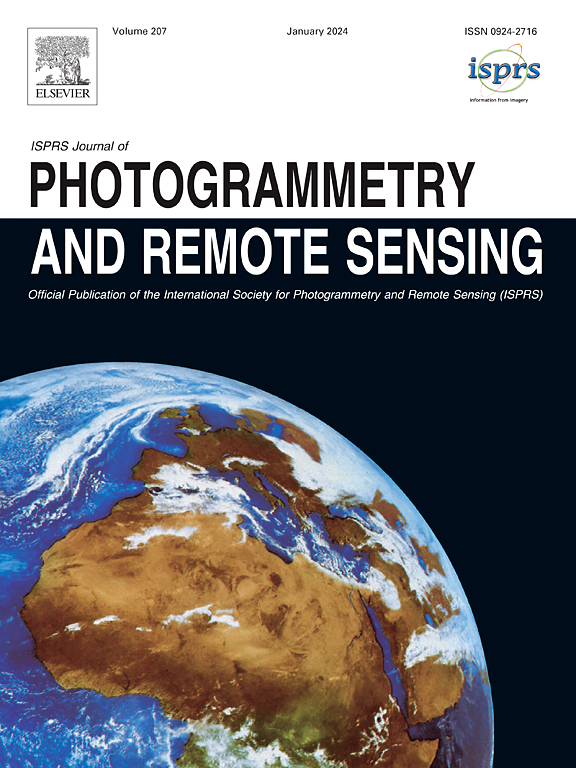Pose-graph optimization for efficient tie-point matching and 3D scene reconstruction from oblique UAV images
IF 10.6
1区 地球科学
Q1 GEOGRAPHY, PHYSICAL
ISPRS Journal of Photogrammetry and Remote Sensing
Pub Date : 2025-05-15
DOI:10.1016/j.isprsjprs.2025.04.013
引用次数: 0
Abstract
Oblique photogrammetry using unmanned aerial vehicles (UAV) is crucial to 3D scene reconstruction. Nevertheless, oblique images are generally acquired with large overlaps, and sometimes with multiple views. Although this increases the level of data completeness, it introduces additional and sometimes redundant computations in tie-point matching, creating overly dense camera connections in the pose graph for bundle adjustment (BA). This study optimizes the pose graph of oblique UAV images by removing redundant image connections to guide tie-point matching. Assuming a five-camera system for oblique image collection, a pose graph called a topologically connected camera network (TCN) was initially constructed using position and orientation system (POS) data to determine the spatial connectivity among oblique images. Second, five geometric meta-parameters of overlapping images were constructed, and their influence on tie-point matching was analyzed using a data-driven approach to generate a weighted pose graph. Third, the weighted pose graph was simplified to a degree-bounded skeletal camera network (D-SCN) using the proposed two-stage multi-objective graph optimization approach. Finally, the D-SCN was embedded into a structure from motion (SfM) pipeline to produce a novel D-SCN–SfM method to reduce the required computations for tie-point matching. The proposed D-SCN-SfM method was tested using data from three large sites, each containing over 5,000 images. In addition, the D-SCN-SfM method was compared with three state-of-the-art methods. The experimental results indicate that our method can significantly reduce the required computations for tie-point matching to 1/14–1/20 as compared to a method that uses only topological constraints, that is, TCN, saving 89–92% of the time expenditure. Furthermore, the accuracy and completeness of the 3D geometry produced by the proposed method were comparable to those produced by standard SfM methods. The source code of our approach is publicly available at https://github.com/qiuda16/D-SCN.
基于姿态图优化的无人机斜向图像高效结合点匹配与三维场景重构
利用无人机进行倾斜摄影测量是三维场景重建的关键。然而,斜向图像通常是通过大重叠获得的,有时是多个视图。虽然这提高了数据的完整性,但它在结合点匹配中引入了额外的,有时甚至是冗余的计算,在姿态图中创建了过于密集的相机连接,用于束调整(BA)。本研究通过去除冗余图像连接,优化无人机斜向图像的位姿图,引导结合点匹配。假设有一个五相机系统用于斜向图像采集,首先利用位置和方向系统(POS)数据构建了一个称为拓扑连接相机网络(TCN)的姿态图,以确定斜向图像之间的空间连通性。其次,构建了重叠图像的5个几何元参数,并利用数据驱动的方法分析了它们对结合点匹配的影响,生成了加权位姿图;第三,采用提出的两阶段多目标图优化方法,将加权位姿图简化为度有界骨架相机网络(D-SCN)。最后,将D-SCN嵌入到运动结构(SfM)管道中,产生一种新的D-SCN - SfM方法,以减少连接点匹配所需的计算量。提出的D-SCN-SfM方法使用来自三个大型站点的数据进行了测试,每个站点包含超过5,000张图像。此外,将D-SCN-SfM方法与三种最先进的方法进行了比较。实验结果表明,与仅使用拓扑约束即TCN的方法相比,我们的方法可以将连接点匹配所需的计算量显著减少到1/14-1/20,节省了89-92%的时间支出。此外,该方法生成的三维几何图形的精度和完整性可与标准SfM方法相媲美。我们的方法的源代码可以在https://github.com/qiuda16/D-SCN上公开获得。
本文章由计算机程序翻译,如有差异,请以英文原文为准。
求助全文
约1分钟内获得全文
求助全文
来源期刊

ISPRS Journal of Photogrammetry and Remote Sensing
工程技术-成像科学与照相技术
CiteScore
21.00
自引率
6.30%
发文量
273
审稿时长
40 days
期刊介绍:
The ISPRS Journal of Photogrammetry and Remote Sensing (P&RS) serves as the official journal of the International Society for Photogrammetry and Remote Sensing (ISPRS). It acts as a platform for scientists and professionals worldwide who are involved in various disciplines that utilize photogrammetry, remote sensing, spatial information systems, computer vision, and related fields. The journal aims to facilitate communication and dissemination of advancements in these disciplines, while also acting as a comprehensive source of reference and archive.
P&RS endeavors to publish high-quality, peer-reviewed research papers that are preferably original and have not been published before. These papers can cover scientific/research, technological development, or application/practical aspects. Additionally, the journal welcomes papers that are based on presentations from ISPRS meetings, as long as they are considered significant contributions to the aforementioned fields.
In particular, P&RS encourages the submission of papers that are of broad scientific interest, showcase innovative applications (especially in emerging fields), have an interdisciplinary focus, discuss topics that have received limited attention in P&RS or related journals, or explore new directions in scientific or professional realms. It is preferred that theoretical papers include practical applications, while papers focusing on systems and applications should include a theoretical background.
 求助内容:
求助内容: 应助结果提醒方式:
应助结果提醒方式:


